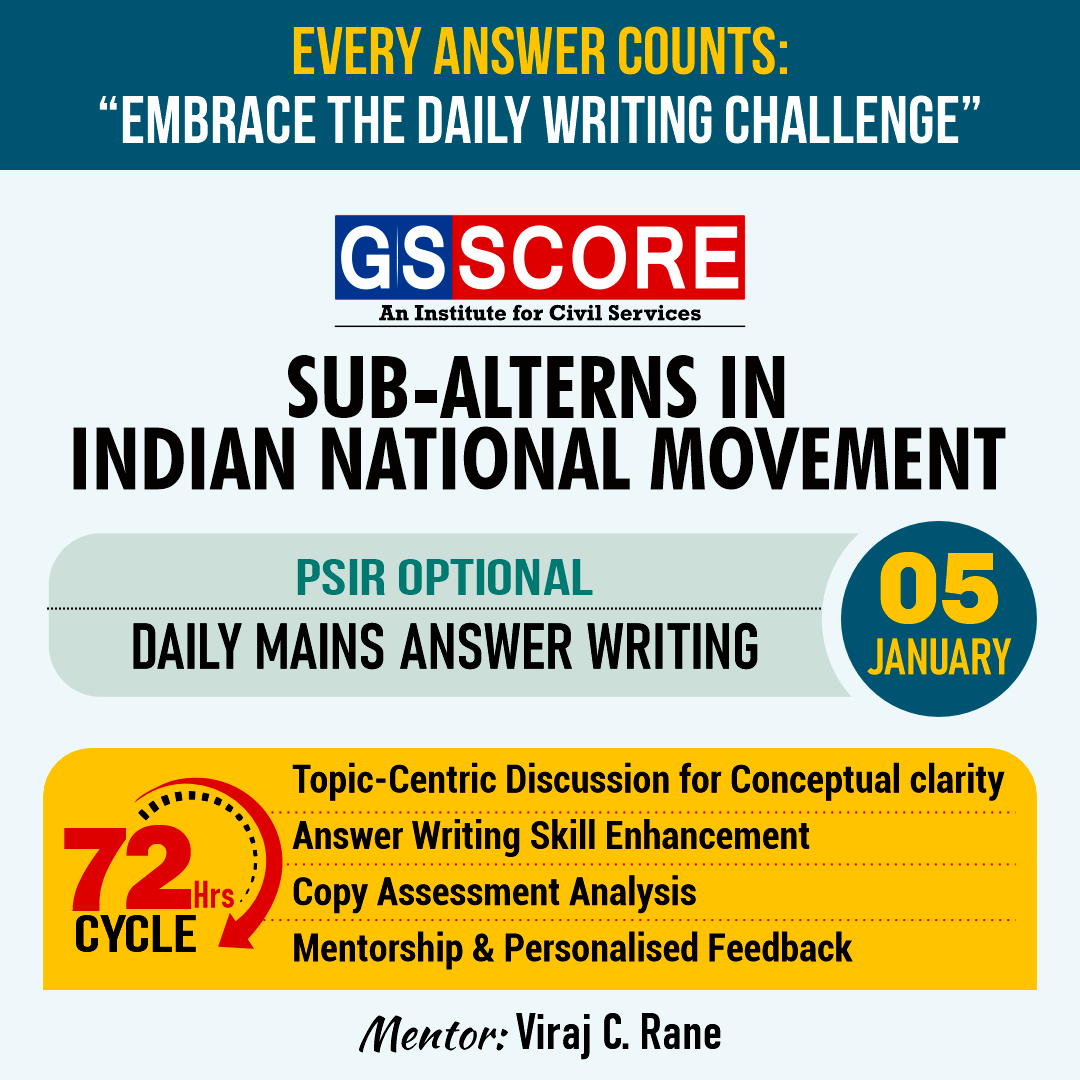


Instruction:
- There will be 2 questions carrying the First Question is-10 marks Write your answers in 150 words and the Second Question is-15 marks Write your answers in 250 words.
- Any page left blank in the answer-book must be crossed out clearly.
- Evaluated Copy will be re-uploaded on the same thread after 2 days of uploading the copy.
- Discussion of the question and one to one answer improvement session of evaluated copies will be conducted through Google Meet with concerned faculty. You will be informed via mail or SMS for the discussion.
Question #1. The emergence of the working class as an organized, self-conscious, all India class is inextricably linked with the Indian National Movement. Analyse 10 marks (150 words)
Question #2. What has been the contribution of tribal community in the freedom struggle of India? 15 marks (250 words)
(Examiner will pay special attention to the candidate's grasp of his/her material, its relevance to the subject chosen, and to his/ her ability to think constructively and to present his/her ideas concisely, logically and effectively).
STEPS & INSTRUCTIONS for uploading the answers
Step 1 - The Question for the day is provided below these instructions. It will be available at 7:00 AM.
Step 2 - Uploading of Answers : Write the answer in A4 Sheet leaving proper margins for comments and feedback and upload the PDF in MY ACCOUNT section. Click on the option of SUBMIT COPY to upload the PDF.
Step 3 - Deadline for Uploading Answers: The students shall upload their answers by 7:00 PM in the evening same day. The first 50 copies will be evaluated.
Step 4 - Feedback : Mentors will give their feedback for the answers uploaded. For more personalised feedback, join our telegram channel by clicking on the link https://t.me/mains_answer_writing_cse . A one-to-one session will be conducted with the faculty after copy evaluation in 72 Hrs.
Model Answer
Question #1. The emergence of the working class as an organized, self-conscious, all India class is inextricably linked with the Indian National Movement. Analyse 10 marks (150 words)
Approach:
- Introduction: The mergence and the reason for rise of working-class movements.
- Body: The evolution over the years; early nationalists view, contribution of the communist and AITUC.
- Conclusion: Limitations and evolution in the post independent phase.
The working class forms a major pressure group in the present day. The modern worker makes his appearance in India in the second half of the 19th century with the slow beginnings of modern industry and the growth of utilities like the railways and the post and the telegraph network. The reasons for rise of working-class movements:
- Destruction of traditional cottage and village industry led unemployment and availability of cheap labour who were exploited.
- The working conditions were very poor; the provisions of factory act were frequently flouted as their intent was not to improve the workers’ conditions but to reduce the competitiveness of the Indian Industry.
- NM Lokhanday formed the Bombay Mill Hands Association.
- Nationalists such as G.S. Agarkar, B.C. Pal, C.R. Das and G. SubramaniaIyer spoke for pro-labour reforms.
Early Nationalists views on the working-class movement:
- Early nationalists, had luke warm attitude, towards the question of workers at this time, because they believed that when anti-imperialist movement was in its very infancy, it may weaken the struggle against British rule by creating divisions within ranks of Indian people.
- DadabhaiNaoroji, in the very second session of the Indian National Congress (1886), made it clear that the Congress ‘must confine itself to questions in which the entire nation has a direct participation.
Other influences on the labour movement:
- The Swadeshi upsurge of 1903-8 was a distinct landmark in the history of the labour movement. An official survey pinpointed the rise of the ‘professional agitator’ and the ‘power of organization’ of labour into industrial strikes as the two distinct features of this period.
- The labour movement had graduated from relatively unorganized and spontaneous strikes on economic issues to organized strikes on economic issues with the support of the nationalists.
- The Socialist and communist influences from the Russian revolution also had a profound impact on them.
- Mahatma Gandhi’s first hunger was for the Ahmedabad Mill Workers Strike. He succeeded in getting positive terms for the workers.
1920- 1930 period
- The All-India Trade Union Congress (AITUC) under the stewardship of Tilak and LalaLajpat Rai gave a new life to the workers movement.
- Railway workers struck in support of the Rowlatt agitation and the Non-Cooperation and Khilafat Movement.
- The communist groups formed the Workers’ and Peasants’ Party under leadership of Dange, PC Joshi and gave it a radical leaning.
- Workers were organised against the Trade dispute Bills,192.
1930-Independence:
- Workers participated in the Civil Disobedience Movement all over the country. The textile workers of Sholapur, transport and mill owners of Calcutta, and the mill workers of Madras, clashed with the Government during the movement.
- The pro-labour attitude of many of the Congress ministries during 1937-39 further gave impetus.
- Quit India Movement, however, did not leave the working class untouched. Immediately after the arrest of Gandhiji and other leaders on 9 August 1942, following the Quit India Resolution, there were strikes and hartals all over the country, by workers in Delhi, Lucknow, Bombay, Nagpur, Ahmedabad, Madras, etc
Conclusion:
The organised working class was a very small proportion of the Indian population during colonial times. Yet, its concentration in certain important cities gave it cohesion and political visibility Although the workers were inspired by the nationalist sentiments, the Congress could not consistently mobilise them in its movements because it did not take up the core issues of the workers and did not support their militant movements due to the fear of antagonising the Indian industrialists. But, the contributions of the working remain invaluable and it made them more conscious and better organised during the post independent phase.
Question #2. What has been the contribution of tribal community in the freedom struggle of India? 15 marks (250 words)
Approach:
- Intro: Colonial rule led to loss of land and culture for the tribals and they revolted.
- Body: Prominent tribal uprisings in the India freedom struggle.
- Conclusion: Despite being over powered by the British, they inspired the country to fight against the foreign yoke.
The colonial rule resulted in what RanajitGuha has called the “revitalization of landlordism”. Due to the changes in property relations, the peasants lost their occupancy right and were turned into tenants-at-will, which meant a great transformation in their status. The high land revenue demand increased the peasants’ need for credit and that enhanced the power of the moneylenders and merchants over the rural society. In the words of RanajitGuha, the landlords, moneylenders and the state thus came to constitute “a composite apparatus of dominance over the peasant”.
The tribal peasants enjoyed autonomy of culture, which was based on an egalitarian ethos. The new forest regulations appeared as encroachments on their natural rights. The imposition of British rule, resulted in the loss of their autonomous domains of power, freedom and culture. The destruction of their imagined golden past by the intruding outsiders—the suds and dikus—led to violent outbursts. Some of the prominent tribal uprisings were:
- Santhal Rebellion: The Permanent Settlement Act of 1793 proved to be disastrous for the agriculturists. Money lenders created a debt burden on them. The Santhals rebelled against the British colonial state and proclaimed the complete ‘annihilation’ of the alien regime. The British suppressed the rebellion with a heavy hand. It was after the Santhal Revolt of 1855-56 that the SanthalParganawas created with special laws within it.
- The Kols of Chhota Nagpur rebelled from 1820 to 1837. Thousands of them were massacred before British authority could be re-imposed.
- The hill tribesmen of Rampa in coastal Andhra revolted in March 1879 against the depredations of the government-supported mansabdar and the new restrictive forest regulations.
- The rebellion (ulgulan) of the Munda tribesmen, led by Birsa Munda, occurred during 1899-19. For over thirty years the Munda sardars had been struggling against the destruction of their system of common land holdings by the intrusion of jagirdar, thikadar (revenue farmers) and merchant moneylenders.
- In Northern parts of Eastern Ghats, the Khonds and Koya rebelled and in the western Ghats saw Ramosi and Bhil rebellion.
- The Chuar uprising of the Chota Nagpur region was also a prominent tribal uprisng.
- In the North East, the Ahom rebellion of 1820, the Kuki revolt of 1920 and the Herakarevbellion by Rani Gaidinlu are a few of many such revolts.
Analysis:
- The British administration considered them as problems of law and order; the rebels were portrayed as primitive savages resisting civilisation.
- The nationalists tried to appropriate the peasant and tribal histories for the purposes of anti-colonial struggle and projected them as the prehistory of modern nationalism.
- Eric Stokes, the historian, would call them “primary resistance, that is, a traditional society’s act of violent defiance, from which usually follows the imposition of colonial rule in response”.
- D.N. Dhanagare regards the rebellions as “pre-political”, because of their lack of organisation, programme and ideology.
- RanajitGuha, on the other hand, has argued that “there was nothing in the militant movements of rural masses that was not political”. They exhibited, first of all, a clear awareness of the relations of power in rural society and a determination to overturn that structure of authority. A clear identification of the enemies was matched by an equally clear marking of the friends. The public character was reinforced by drawing on the corporate labour activity, as the Santhals characterised the rebel actions as their traditional hunting activity; but now hunting had acquired a new political meaning.
Conclusion:
Although most of the rebellions were brutally crushed by the British, the tribal uprisings sent a message to the authorities that injustice to the tribals would not be tolerated. The British made concessions to the to avoid violent attacks. The trial uprising also created awareness in the rural hinterlands against the foreign exploiters. These uprisings gave confidence to the India people that the British can be fought and overthrown.

